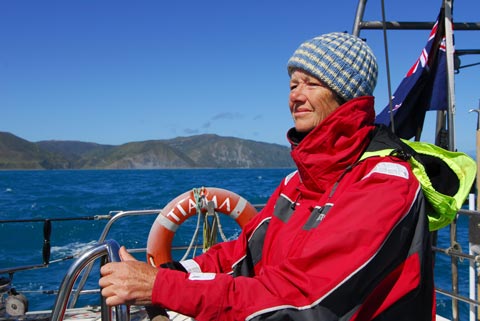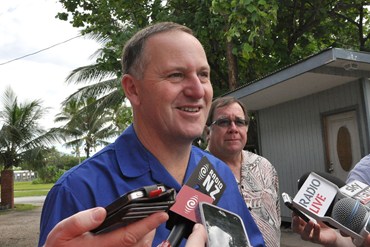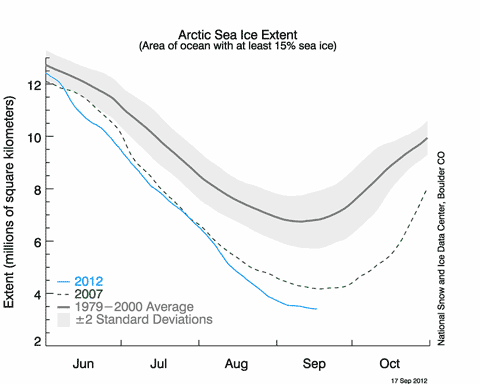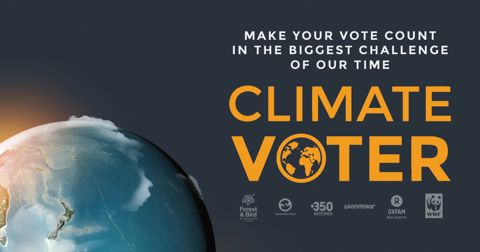A non-partisan campaign to put action on climate change at the centre of the coming election campaign was launched at the weekend (NZ Herald, RNZ). Climate Voter, a joint initiative by Forest & Bird, Generation Zero, 350 Aoteoroa, Greenpeace, Oxfam and WWF, is using social media to drive the campaign, and will host a debate on climate policy between the leaders of the top six polling parties in September. At the time of writing over 10,000 people had signed up to the campaign — including me. It’s a very worthwhile effort and one I’m very happy to support, because as long as politicians are allowed to get away with mismanaging or ignoring climate policy, NZ will remain on the wrong path. The laws of physics don’t care what your politics are, but they will make people who ignore them pay a high price.
Tag: Greenpeace
Westward Ho: With the Anadarko Flotilla – day one

I’m really pleased to welcome Jeanette Fitzsimons to Hot Topic as a guest blogger. The environmentalist and former co-leader of the NZ Greens is on board the yacht Tiama, sailing out into the Tasman to protest against deep water oil exploration. She will be providing us with regular updates on the flotilla’s progress.
What a fabulous send off. A dozen kayakers, wearing penguin suits, lined up and waved us on our way as we left the harbour. Several small boats sailed with us. About 100 well wishers gathered on the wharf; speeches in support from Green and independent MPs, oil free Wellington, Ora Taiao (climate and health council); two sails spread out on the ground covered with signatures and messages in support of our mission; and home baked cookies and chocolate cake delivered to the wharf by old friends.
I’m on the Tiama, a 50 ft cutter-rigged steel sloop built by skipper Henk, veteran of many campaigns. With us is Bunny from Greenpeace, Barclay who will make a sailor of me by the end of the voyage, and Pascale from France with the camera and the laptop. Later tonight we will pick up two more before heading out to the site 120 miles west of Raglan where Texas oil giant Anadarko has been invited, nay begged, even subsidised, by our government to try a repeat exercise of what went wrong in the Gulf of Mexico in 2010.
The Baltazar is sailing with us, skippered by Andy Whittaker, and we plan to rendezvous on Saturday on site with four other boats which left from Auckland, Bay of Islands and Bluff.
Anadarko says that coming out to their drilling site is dangerous. Yeah, right. Who’s causing the danger, drilling under 1500 m of water, knowing the very similar Macondo Prospect they part-owned in the Gulf of Mexico blew out, spewing 650,000 tonnes of oil?
If that happened here, it would take weeks for emergency clean up equipment to arrive from overseas. While we waited the oil would spread, contaminating our coast from Taranaki to the Hokianga and poisoning the whole marine web of life: including our fisheries, seabirds, whales, the Maui dolphin and coastal communities.
Continue reading “Westward Ho: With the Anadarko Flotilla – day one”
Our “fair share” of future disaster
 The New Zealand Government has taken refuge from the challenge of climate change by recasting it as a matter of political positioning. This is nowhere more clearly seen than in the frequently reiterated claim that we are doing our “fair share” in the international effort to reduce emissions. It’s a brash claim in any case, when our unconditional 5 percent reduction target on 1990 levels by 2020 is compared with the 30 percent unconditional target of Norway and Switzerland or the 20 percent target of the EU as a whole. But the Government prefers comparison with our “trading partners” Australia, America and Canada, and also largely excludes the emissions associated with farming on the grounds that the world needs the food we produce.
The New Zealand Government has taken refuge from the challenge of climate change by recasting it as a matter of political positioning. This is nowhere more clearly seen than in the frequently reiterated claim that we are doing our “fair share” in the international effort to reduce emissions. It’s a brash claim in any case, when our unconditional 5 percent reduction target on 1990 levels by 2020 is compared with the 30 percent unconditional target of Norway and Switzerland or the 20 percent target of the EU as a whole. But the Government prefers comparison with our “trading partners” Australia, America and Canada, and also largely excludes the emissions associated with farming on the grounds that the world needs the food we produce.
But brash or not what is convenient about the “fair share” argument is that it transfers attention from the alarming reality of climate change to the much more familiar and comfortable world of political negotiation. It enables Ministers to busy themselves with trying to get the best deal they can for the country vis-à-vis other countries, to protect the national interest, to preserve competitive advantage. Buried in such useful activity they can pretty well forget the massive and threatening question mark that climate change puts over the continued use of fossil fuels.
On the domestic front it fits well with adversarial politics, as was all too apparent in question time in the House a couple of weeks ago when Green MP Kennedy Graham questioned the Climate Change Minister about the 5 percent reduction target.
Arctic meltdown: two views and a bit of PIG
[youtube http://www.youtube.com/watch?v=G08xPmxR28U&w=480]
From NASA’s Earth Observatory Youtube channel: a great video showing the calving of this year’s Petermann Ice Island. Most impressive is the speed with which it passes down the Nares Strait. And to provide a little North-South symmetry, today’s EO Image of the Day shows the steady enlargement of a giant crack in the Pine Island Glacier in West Antarctica, which will calve the biggest piece of PIG in recent history, sometime soon.
For a somewhat different reaction to what’s going up North, try this video from Greenpeace’s Save The Arctic campaign. Great fun…
[youtube http://www.youtube.com/watch?v=ZOHKu2vFp34&w=480]
Ice bottom blues
[youtube]UaKqhRTqSlg[/youtube]
According to the latest bulletin from the National Snow and Ice Data Center in the US, Arctic sea ice is likely to be at or about its minimum extent for the summer (as of Sept 17th). The animation above shows how the ice melt proceeded through the summer (up to Sept 14th), and the graph below shows the extent as of Sept 17th — 3.41 million square kilometres (1.32 million square miles).

The NSIDC notes:
The current extent is 760,000 square kilometres (293,000 square miles) below the previous record minimum extent in the satellite record (4.17 million square kilometres or 1.61 million square miles) which occurred on September 18, 2007. This difference is larger than the size of the state of Texas. The ice extent currently tracks nearly 50% below the 1979 to 2000 average minimum extent.
For an insight into what the ice is really like, I recommend Julienne Stroeve’s blog of her trip on the Greenpeace vessel Arctic Sunrise. This is from her most recent entry (Sept 17th):

